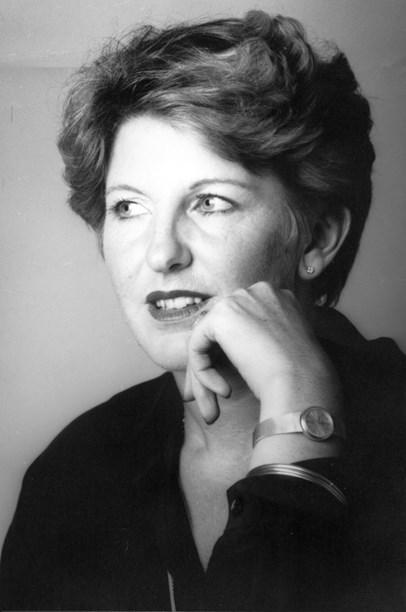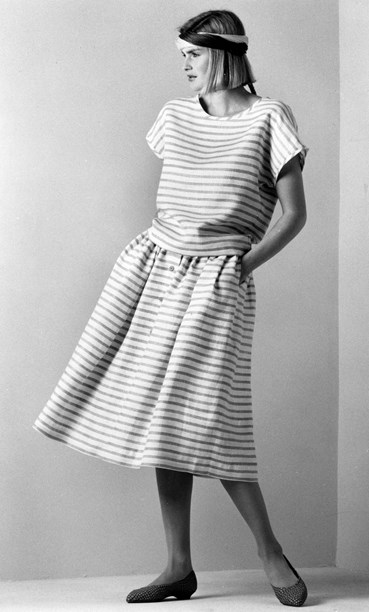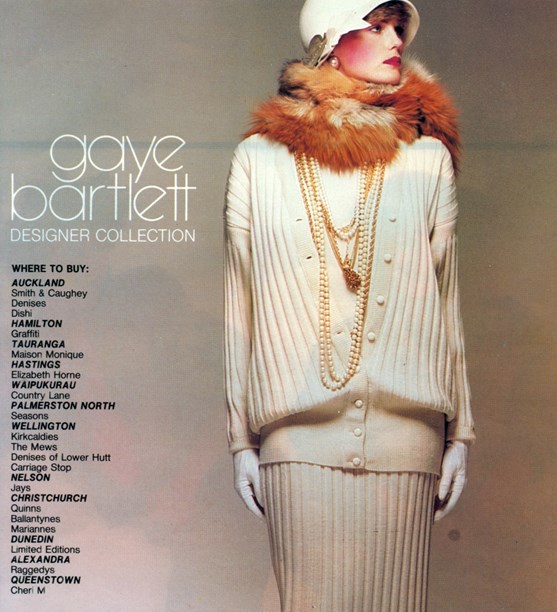Stories
Gaye Bartlett
1945-

A third generation member of a prominent rag-trade family, Gaye Bartlett (nee Lewis) had a long and successful career in the garment industry as a designer and retailer.
To say she was born with a thimble on her finger and a pair of dressmaker’s shears in her hand is an exaggeration but, given her family history, a fashion career seemed almost inevitable.

Gaye Bartlett.
Gaye’s grandfather Joe Lewis came to New Zealand from England and settled in Wellington prior to World War One. A tailor by trade, he set up a group of tailoring shops and, in 1926, participated in the takeover of an existing company which became Fashions Ltd, the family firm. During World War Two, the company was requisitioned to make uniforms for the New Zealand armed forces. After the war, Joe’s sons Tony and Bill joined him in the business which continued to operate from the Gas Company Building in Wellington’s Courtenay Place.
Fashions Ltd manufactured British labels such as Dereta, Eastex and Gor-Ray under license and also California Cottons, a summer range from the USA. In 1967, the operation moved to Auckland where the Lewis’s acquired clothing company Classic Manufacturing Ltd. Known henceforth as Classic Fashions Ltd, the business continued to make franchised labels. These included Lesley Fay, Jonathan Logan, Petite Vogue, Act III and Esprit. Classic Fashions is still operating today, under new ownership. The other divisions, including Esprit, were closed by the early 2000s.
As a child, Gaye made frequent visits to the Gas Company Building and says it was here that her grandfather nurtured her love of fashion. "Fabric texture and quality was emphasised while colour and trims were explained and demonstrated as only a grandparent can do." She describes watching with fascination, the fabric being cut into pieces and made into garments by the machinists, and the garments stacked in piles before arriving in the pressing room.
Gaye’s mother also fostered her daughter’s interest in fashion, arranging for her to learn pattern-making at night-school in her early teens. She became proficient at cutting and construction. These accomplishments led to her being accepted as a design cadet by Norma Tullo, Australia’s answer to Mary Quant, when her immediate family moved to Melbourne in the early 1960s to enable her father, a paediatrician, to further his studies.
In 1964, Gaye returned to Wellington to work in the trim department at Fashions Ltd and learn other aspects of the trade. Marriage and three children followed and, until relocating to Christchurch in 1979, she made clothes, including bridal-wear, for private clients and for retail.
Following her arrival in Christchurch, Gaye purchased Accent on Fashion, a blouse and skirt operation with a manufacturing plant and retail site in Gloucester Street and another shop in the newly opened Shades Arcade. The venture didn’t last long. Shortly thereafter, she closed the business, moved to a bigger shop in the Shades and started designing under her own name.
An approach by Douglas McCaul to join him at M G McCaul & Co to assist in the design of Stylemaster skirts, included the offer to manufacture the Gaye Bartlett label and allow her to pursue its development. Her fabrics, predominantly silk, cotton, linen and wool, were sourced on buying trips overseas and her focus was always on soft rather than hard tailoring. With more than 30 shops stocking her label, her city suits, well-mannered dresses, immaculate jackets, summer casuals and evening separates found their way into the wardrobes of fashionable women throughout the country.

Gaye Bartlett summer separates, 1986. Image © Gaye Bartlett.
Friendships Gaye formed during this period with Christchurch fashion pioneers Paula Ryan, editor of Fashion Quarterly magazine, and New Zealand Fashion Week founder Pieter Stewart were to prove enduring. Her clothes featured regularly in Fashion Quarterly, and when her overseas buying trips coincided with Paula Ryan doing fashion shoots in Venice, Paris and London, she lent a hand, "carrying garments to shoot locations, assisting with dressing models and generally helping out". She later produced the basic patterns for Paula’s Simply You Essentials clothing range and was part of Pieter Stewart’s think tank on the development of New Zealand Fashion Week.

Advertisement for Gaye Bartlett Designer Collection, Fashion Quarterly 1986. Image © Gaye Bartlett.
Working on two ranges, Stylemaster and her own, as well as managing the Gaye Bartlett shop in the Shades, eventually took its toll. In the late 1980s, Gaye sold the lease on the latter, parted company with M G McCaul and set up a costume jewellery importing business, Gaye Bartlett Promotions. She continued with the knitwear collections she had developed as part of her range at McCaul’s, and produced a small linen range under the Gaye Bartlett label.
In Christchurch, Gaye’s knits were manufactured by Kahu Knitwear. When she moved to Auckland in 1989, Private Collections took over the production. She joined the company and helped develop their Recent Works knitwear range while continuing with her own fashion knits collection.

Knit ensemble, 1994. Image © Fashion Quarterly
Gaye’s association with Private Collections continued until 1995 when she relaunched her eponymous clothing label and opened The Concept Store on Auckland’s Ponsonby Road. Her design ethos differed from that of the 1980s in that the tailoring component diminished. Her new collections, which sat comfortably alongside her knitwear, comprised seamlessly moulded, fluid fashion separates designed to be layered and worn in multiple ways. A second label, created by Gaye’s only daughter Deanne, was launched in 1998.
Acknowledging the disparities between the female form in different countries, and the angst suffered by larger women when shopping for clothes, Gaye changed the way she sized her collections. Sizes 10 - 12 were relabelled One, 12 - 14 Two, 14 - 16 Three and 16 - 18 Four. "Sizes 10 to 18 said you’re small – you’re big," she says. "My sizing was more subtle." She also adapted her sizing to suit the body shapes of New Zealand women and addressed the variations within these body shapes.
In her long career, Gaye Bartlett participated in many major New Zealand fashion events and trade promotions. One of ten New Zealand designers selected to show their collections in The New Zealand Fashion Experience in Sydney and Melbourne in 1985, she was invited by the New Zealand Wool Board to promote cool wool fashions at the Perth Royal Show as part of the off-water events at the America’s Cup two years later.

Gaye Bartlett and Peter Nola of Peppertree Fashions judging Fashions in the Field competition, Wellington Cup, late 1980s.
With other notable Christchurch designers, including Barbara Lee, Nita Henry and Rosaria Hall, Gaye took part in the Kiwi Lager Canterbury Designers Collection organised by Pieter Stewart in 1988 to stimulate interest in Fashions in the Field on Cup Day. She was involved with the Corbans (later Wella) Fashion Collections from their inception and the Benson & Hedges Fashion Design Awards, as a manufacturer, not a competing designer.
Following the presentation of their 2002 Autumn/Winter collections at New Zealand Fashion Week in 2001, Gaye Bartlett, RJC, Obi and Saga were chosen to represent New Zealand at the Melbourne Fashion Festival, Australia’s most important consumer fashion event. Gaye’s collection, inspired by New Zealand flora and fauna, showcased interesting knit techniques.

Panelled tunic and skirt in burnout velvet. Gaye Bartlett 2003 Autumn/Winter collection. New Zealand Fashion Week 2002.
Gaye was no stranger to the Australian market. In 1999, Australian exports accounted for 80 per cent of her output, and her range sold in every State except Tasmania.
Gaye Bartlett produced her last collection in 2003. In 2004, she moved to Central Otago and, for the past eight years, has lived in Arrowtown where she pursues her interest in gardening and cooking, and plays bridge and mah-jong. She says her life is much quieter now, but after a hectic career she believes it is well-deserved.
Text by Cecilie Geary. Banner image of Gaye Bartlett (left) with fellow designer Denise L'Estrange-Corbet in 1996.
Last published September 2016.